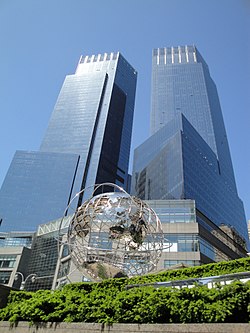 Final logo used from 2010 to 2016 | |
 Time Warner Center, formerly the headquarters of the company in New York City. It was shared by its namesake, but then unrelated company, Time Warner. | |
| Formerly | Television Communications Corp. (1962–1973) Warner Cable (1973–1979, 1986–1992) Warner-Amex Cable (1979–1986) |
|---|---|
| Company type | Public |
| NYSE: TWC | |
| Industry | |
| Predecessor | American Television and Communications (1968–1991) |
| Founded |
|
| Defunct | May 18, 2016 |
| Fate | Acquired by Charter Communications and merged with Bright House Networks to form Charter Spectrum |
| Successor | Charter Spectrum |
| Headquarters | Time Warner Center, , United States |
Area served | United States |
Key people | Robert D. Marcus (chairman & CEO) |
| Parent | Kinney National Company (1972) Warner Communications (1972–1990) American Express (1979–1986) Time Warner (1990–2009) |
| Subsidiaries | Time Warner Cable Inc. |

Time Warner Cable Enterprises LLC was an American cable television company. Before it was acquired by Charter Communications on May 18, 2016, it was ranked the second largest cable company in the United States by revenue behind only Comcast, operating in 29 states. [1] Its corporate headquarters were located in the Time Warner Center in Midtown Manhattan, New York City, [2] with other corporate offices in Stamford, Connecticut; Charlotte, North Carolina; and Herndon, Virginia. [3]
Contents
- History
- Background
- Sale to Charter Communications and company closure
- Residential services
- Business services
- Cable Internet service
- Naming rights
- Acquisitions
- Adelphia
- NaviSite
- Insight Communications
- DukeNet Communications
- Advance/Newhouse and Time Warner Entertainment (Bright House Networks spin off)
- Controversies
- Bandwidth metering
- Signal intrusion and accidental transmission of pornography
- Cable clusters
- Divisions
- West Region
- East Region
- Former divisions
- Rankings
- See also
- References
It was controlled by Warner Communications, then by Time Warner (later known as WarnerMedia and presently Warner Bros. Discovery). The company had spun off its cable operations in March 2009 as part of a larger restructuring. From 2009 to 2016, Time Warner Cable was an entirely independent company, continuing to use the Time Warner name under license from its former parent company (including the "Road Runner" name for its Internet service, that was merged into what is now Spectrum Internet).
In 2014, the company was the subject of a proposed purchase by Comcast Corporation, valued at $45.2 billion; however, following opposition to the deal by various groups, along with plans by the U.S. government to try to block the merger, Comcast called off the deal in April 2015. On May 26, 2015, Charter Communications announced that it would acquire Time Warner Cable for $78.7 billion, along with Bright House Networks in a separate $10.1 billion deal, pending regulatory approval. [4]
The purchase was completed on May 18, 2016; Charter had continued to do business as Time Warner Cable in its former markets, but has now re-branded these operations under the Spectrum brand in most markets (a brand of Charter which launched in 2014), though it will continue to offer the roadrunner.com email addresses and adelphia.net email addresses to new customers. [5]


